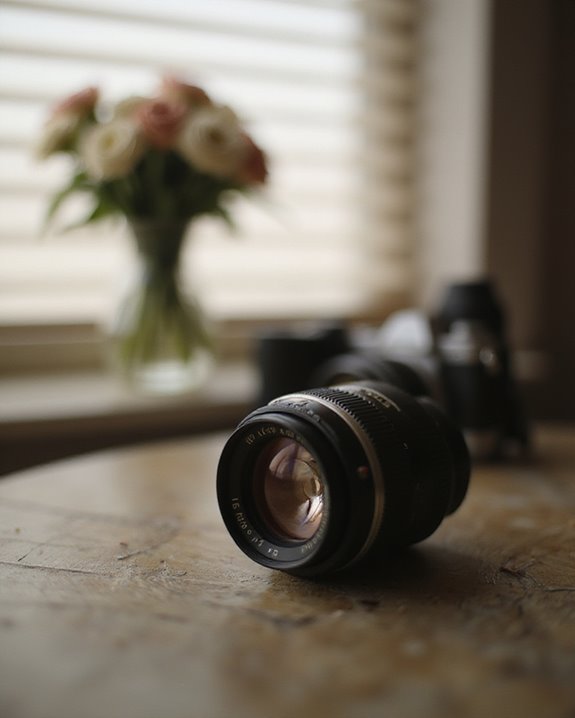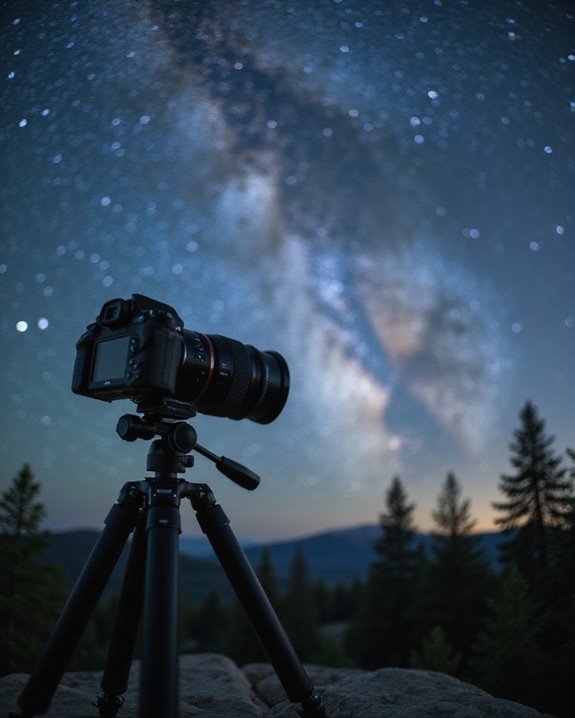Wide-angle prime lenses between 14mm and 24mm focal length exhibit ideal aurora capture due to expansive sky coverage and precise framing at high latitudes. Aperture specifications from f/1.4 to f/2.8 maximize photon intake, enabling reduced exposure times (4–10 seconds) and lower ISO settings (1600–3200), thereby minimizing noise in low-light conditions. Models such as Sigma 14mm f/1.8 ART and Sony 14mm f/1.8 GM achieve superior sharpness and light collection compared to zoom alternatives, which may introduce edge distortion. Additional technical considerations on focusing and lens calibration refine aurora imagery quality.
Key Takeaways
- Wide-angle prime lenses between 14mm and 24mm with apertures f/1.4 to f/2.8 capture expansive aurora skies with optimal light intake.
- Fast primes like Sigma 14mm f/1.8 or Sony 14mm f/1.8 GM enable shorter exposures and lower ISO for sharper Northern Lights photos.
- Manual focus with accurate infinity calibration is essential to avoid blurred aurora images in low-light conditions.
- Affordable options include Rokinon 14mm f/2.8 or Samyang/Rokinon 24mm f/1.4 for wide fields and good low-light performance.
- Zoom lenses (14-35mm) offer framing flexibility but may sacrifice sharpness and increase edge distortion compared to prime lenses.
Understanding the Importance of Lens Choice for Aurora Photography
The selection of an appropriate camera lens fundamentally influences the quality and scope of aurora photography, particularly in capturing the dynamic and expansive nature of the Northern Lights. Wide-angle lenses with focal lengths ranging from 14mm to 24mm are essential, as they enable extensive coverage of the night sky, accommodating full-sky auroras in high latitudes or horizon arcs in lower latitudes. Prime lenses with wide apertures, typically between f/1.4 and f/1.8, optimize light intake under low light conditions, facilitating shorter exposure times that effectively freeze aurora movement, thereby minimizing motion blur. For instance, the Sigma 14mm f/1.8 and Sony 14mm f/1.8 GM lenses combine ultra-wide focal lengths with fast apertures, delivering sharp, high-quality images critical for aurora photography in regions such as Northern Canada and the Northern US. Additionally, lenses equipped with image stabilization features can help produce sharper images in challenging lighting conditions without the need for tripods, further enhancing aurora captures.
Ideal Aperture Settings for Capturing the Northern Lights
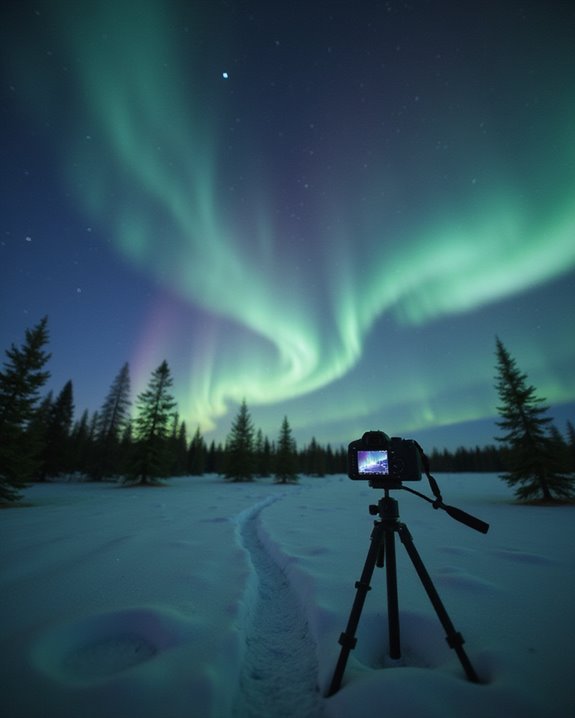
Ideal aperture settings for capturing the Northern Lights primarily fall within the range of f/1.4 to f/2, as these apertures maximize light intake under low-light conditions while enabling exposure durations between 4 and 10 seconds to effectively freeze auroral motion. Wide lenses with a large aperture, such as an ultra-wide angle lens, are preferred for their light-gathering capabilities. Fast lenses like the f/1.4 lens or F1.8 lens, including models like the Sigma 14mm f/1.8, facilitate lower ISO settings (1600-3200), reducing noise compared to narrower apertures. Apertures narrower than f/2.8 often necessitate higher ISOs (5000-6400), increasing grain and reducing image quality. Thus, selecting a lens for Northern Lights with an f/1.4 aperture or similar fast aperture optimizes performance, balancing exposure time, noise, and sharpness in aurora photography. Additionally, the optical performance of a lens, including its ability to produce sharp images with minimal aberrations, plays a crucial role in capturing clear, vibrant aurora photos.
Choosing the Right Focal Length for Aurora Displays

Selecting an appropriate focal length greatly influences the compositional scope and detail resolution in aurora photography, complementing aperture considerations previously outlined. Effective lenses for aurora typically require focal lengths wide enough to capture expansive Northern Lights displays. At high latitudes such as Arctic regions, a 14mm prime lens with a wide aperture lens design enables extensive sky coverage, essential for capturing the aurora in all directions. Conversely, in lower latitudes like the Northern US or Vancouver, a 24mm focal length better frames Aurora Borealis arcs near the horizon while preserving color detail. Prime lenses at 14mm and 24mm outperform narrower lenses such as 35mm by maximizing field of view and light intake. Thus, selecting between 14mm and 24mm focal lengths depends on geographical aurora visibility, optimizing the ability to capture the aurora effectively. Additionally, understanding lens aperture capabilities is crucial for maximizing light collection in low-light aurora conditions.
Comparing Prime and Zoom Lenses for Northern Lights
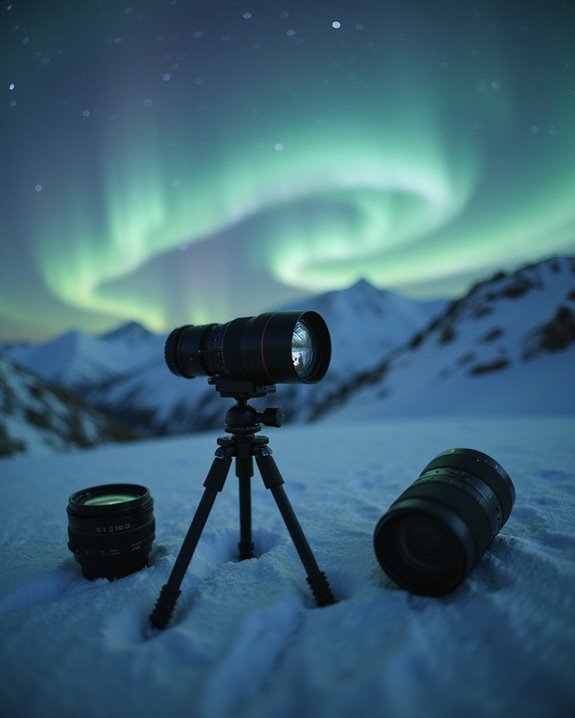
Comparisons between prime and zoom lenses for Northern Lights photography reveal distinct trade-offs in optical performance, flexibility, and operational practicality under low-light conditions. Prime lenses, such as the Rokinon 14mm f/2.8 and Sigma 14mm f/1.4 DG DN Art, offer wider apertures (f/1.4 to f/2.8) enabling superior light gathering and lower ISO settings, enhancing image quality when shooting northern lights. Zoom lenses like the Canon RF 15-35mm f/2.8 and Sigma 14-24mm f/2.8 Di provide focal length versatility from 14mm to 35mm, facilitating variable framing without repositioning. However, zoom lenses generally weigh more and may exhibit reduced sharpness and edge distortion compared to primes. Budget considerations favor affordable primes such as the Rokinon 14mm f/2.8, while zoom lenses carry higher costs but offer operational flexibility. Selecting the best lens(es) depends on balancing aperture speed, focal range, weight, and cost to effectively photograph the northern lights.
Best Lenses for High Latitude Aurora Photography
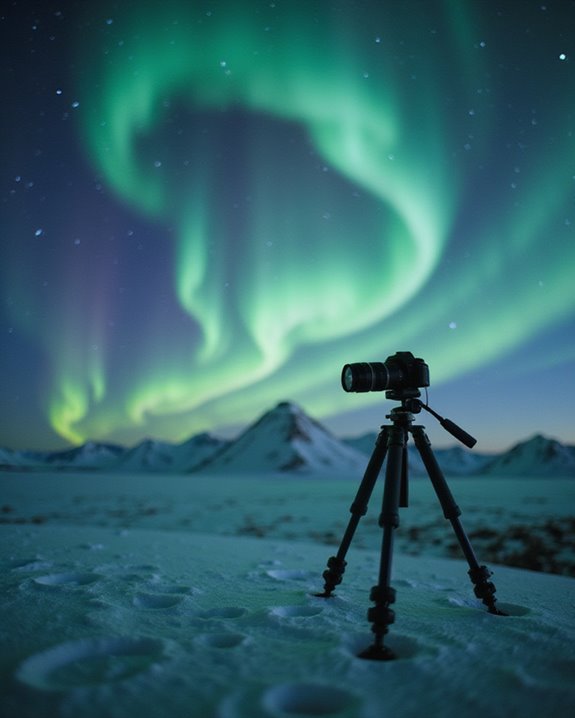
High latitude aurora photography necessitates lenses that combine a wide field of view with fast apertures to effectively capture expansive and dynamic auroral displays. The best lenses for shooting the Northern Lights in these regions typically feature focal lengths around 14mm, providing extensive sky coverage essential for overhead aurora events. The Sigma 14mm f/1.8 ART lens, compatible with Canon, Nikon, Sony, and L-mount mirrorless camera systems, delivers a fast aperture ideal for low-light photography. Similarly, the Sony 14mm f/1.8 GM lens balances a wide field of view with a lightweight design (460 g), enhancing portability during extended shoots. Alternatives like the Sigma 14mm f/1.4 DG DN Art and the cost-effective Rokinon 14mm f/2.8 offer varying aperture-speed trade-offs, optimizing exposure and detail when shooting the aurora. These lenses collectively represent the best lens(es) for high latitude aurora photography.
Lens Recommendations for Lower Latitude Aurora Viewing
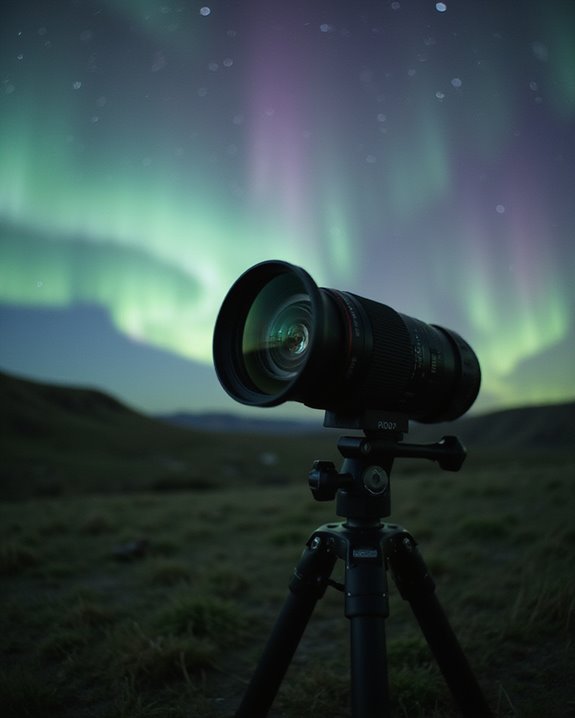
Lens selection for aurora photography at lower latitudes, such as the northern United States and Vancouver, requires consideration of focal length and aperture to optimize framing and exposure of auroral arcs near the horizon. The best lens(es) for this context typically feature a 24mm focal length, balancing wide-angle capture with sufficient detail to photograph the aurora effectively. Canon EF and Nikon Z mount lenses offering fast apertures, such as the Sigma ART 24mm f/1.4 or Sony GM 24mm f/1.4, provide superior image quality and low-light performance, reducing ISO requirements while maintaining sharpness. Zoom lenses like the Tamron 17-28mm f/2.8 add framing versatility. For budget-conscious users, Rokinon’s 24mm f/1.4 is a viable lens to capture aurora shots with acceptable image quality. Canon lenses remain the best option for compatibility within Canon systems at these latitudes.
The Role of Ultra-Wide Angle Lenses in Northern Lights Photography
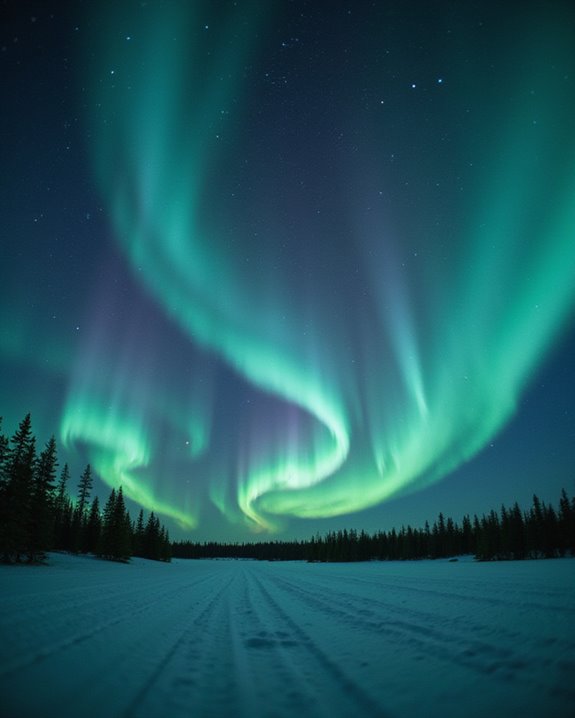
Ultra-wide angle optics, typically ranging from 10mm to 35mm focal lengths depending on sensor size, demonstrate significant advantages in Northern Lights photography by enabling extensive sky coverage and minimizing peripheral distortion common in wider fields. Lenses such as the Sigma 14mm f/1.8 ART or Tamron 15-30mm f/2.8 offer ideal performance on full-frame and crop sensors, capturing a larger portion of the sky essential for Aurora panoramas. These lenses maintain corner sharpness at apertures around f/4, facilitating inclusion of foreground elements to enhance composition. When paired with devices like the Nikon D or Canon EOS series, ultra-wide lenses allow precise manual focus and effective shutter speed adjustment to shoot the Northern Lights with minimal blur. Their capacity to exaggerate aurora features at frame edges improves visual impact without compromising exposure time management.
Managing Exposure Times to Avoid Star Trails and Blur

Managing exposure times is critical to balancing image sharpness and preventing star trails in Northern Lights photography, as Earth’s rotation causes stars to elongate visibly during exposures exceeding approximately 20 seconds. Photographers shooting aurora photos must thus prioritize short exposure durations, typically between 4 to 10 seconds, to capture dynamic Northern Lights without inducing blur or star trails. Longer shutter speeds beyond 13 seconds risk both star elongation and overexposure, especially during active auroral displays. Utilizing mirrorless cameras or compact camera systems with high ISO capabilities (e.g., ISO 6400) enables shorter exposures, such as 2 seconds, effectively freezing aurora motion while maintaining image quality through subsequent noise reduction. Selecting the best cameras for photographing the Northern Lights involves balancing sensor sensitivity with exposure time constraints to optimize sharpness and detail in aurora captures.
Tips for Manual Focusing When Shooting the Aurora

Achieving precise focus is essential for capturing the Northern Lights with clarity, as the low-light environment and rapid auroral movement demand exacting manual focusing techniques. Manual focusing in aurora photography benefits from initial autofocus technique on bright stars or the moon, subsequently switching to manual mode to lock focus. Lens calibration is critical, as infinity focus markers—particularly on lenses like the Rokinon 14mm f/2.8—may misalign, causing blurred results; daylight test shots on distant objects verify true infinity focus. Advanced lenses with integrated focus rings in the viewfinder enhance accuracy, while manual focus lenses such as the Samyang 24mm f/1.4 require careful calibration against known distant points. Continuous verification via test shots under low-light conditions guarantees sharp images, preventing star trails or blurring during exposures typical in Northern Lights photography.
Affordable Lens Options for Budget-Conscious Aurora Photographers

When selecting lenses for aurora photography under budget constraints, the evaluation prioritizes a balance between wide-angle coverage, aperture speed, and cost-efficiency. The Rokinon 14mm f/2.8, priced around $300, offers a wide 14mm field and fast f/2.8 aperture, making it a perfect option to capture one of the best northern lights displays on full-frame and APS-C cameras. The TT Artisan 11mm f/2.8 fisheye lens, available for approximately $235 and compatible with Canon mounts, provides an ultra-wide perspective suitable for framing expansive auroras in low-light conditions. Samyang/Rokinon 24mm f/1.4 lenses deliver a good option for fast aperture shooting, balancing cost and performance. Additionally, used Tamron 15-30mm f/2.8 zooms and older Nikon AIS 24mm f/2.8 lenses present viable, affordable choices for those looking for an affordable lens to see the northern lights in the best places.
Frequently Asked Questions
What Lens Should I Use for Northern Lights?
Wide angle options with fast aperture prime lenses excel in aurora sharpness. Manual focus is preferred, while image stabilization is less critical. Lens hoods and weather sealing enhance durability. Cost effective brand comparisons guide ideal choices.
Can I Use a 50MM Lens for Northern Lights?
A 50mm lens offers prime performance and lens sharpness but has lens limitations for aurora capture due to narrow field. 50mm advantages include nighttime focus; manual mode and exposure techniques aid aurora framing despite reduced lens compatibility for vast skies.
What Kind of Camera Do You Need to Capture the Northern Lights?
Camera types with full-frame sensors excel in low-light, supporting high ISO settings and manual mode for precise shutter speed control. Essential features include tripod mount, RAW format, night mode, robust battery life, and cold resistance for effective Northern Lights capture.
Is an 18-55MM Lens Good for Northern Lights?
The 18-55mm lens faces focal limitations and zoom drawbacks, reducing lens sharpness and aurora colors. Exposure challenges and image distortion arise in night settings, while tripod issues, battery drain, and weather effects further hinder capturing vivid northern lights.


